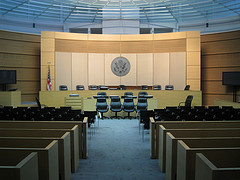 The U.S. Judicial Conference, which helps set policy for federal circuit (appeals) and district (trial) courts, has issued a memo, first reported by Wired's "Threat Level" blog,
that is meant to help individual courts set policies on when and how
smartphones and similar devices can be brought into and used in
courthouses and in courtrooms.
The U.S. Judicial Conference, which helps set policy for federal circuit (appeals) and district (trial) courts, has issued a memo, first reported by Wired's "Threat Level" blog,
that is meant to help individual courts set policies on when and how
smartphones and similar devices can be brought into and used in
courthouses and in courtrooms.
The memo
outlines some of the issues that arise with smartphones and other
electronic devices in courthouses, and informally surveys various
federal courts' existing policies regarding smartphones.
The survey found that 41 of the 94 district courts allow anyone to bring
the devices into their courthouses, often with some restrictions on
their use. Of these 41 courts, nearly a third prohibit the public from
bringing the devices in the courtroom, while the remaining two-thirds
require that devices be kept off or in silent mode without the judge's
permission.
Forty-eight district courts ban devices, except for those possessed by judges, court personnel, and probation and pretrial officers, or with the express permission of a judge. Other courts ban only certain devices, such as devices that include cameras. In both types of situations, courts either check and store the devices or else simply bar individuals from entering with such a device.
Five district courts, according to the survey, had no stated policy on the issue on their websites.
The memo also notes that many district courts have special policies allowing journalists to bring electronic devices into the courthouse, but also notes that only six district courts allow journalists to use these devices in courtrooms, which various restrictions. The memo notes that a consideration in adopting such a policy for journalists is "how to distinguish, if at all, between members of the traditional press and those who report solely through social media sites or other internet venues."
The memo lays out some of the arguments for and against allowing electronic devices in courthouses, including concerns about recording and broadcast of court proceedings (which the memo mistakenly states is barred in all federal district courts; more on that in this post); and the concern that "[t]hese common devices present security issues because some can be and have been converted for use as weapons, including explosives." The Wired blog scoffs at this rationale.
The memo does not recommend that district courts adopt any particular policy,
but lists several factors that courts should consider in formulating a
policy, including:
- which devices will fall under the policy (the memo's list includes cell phones, PDAs, earpiece (Bluetooth) devices, laptops, and digital and other types of video cameras or recorders);
- how the policy will apply to and perhaps distinguish amongst the various types of persons entering the courthouse and courtrooms (see this post for a critique of this approach);
- the lack of court security officer resources to implement such a policy;
- the times, locations, or proceedings at which the devices may be used;
- whether the same policy should apply in every division and courthouse of the district or circuit;
- the policy's effect on access to the courts by the public and family and friends of litigants and criminal defendants, as well as the policy's effects on jury service;
- the policy's effect on other tenants and visitors to the building housing the court;
- whether the court should provide training on the risks and benefits of bringing the such devices into the courthouse or courtroom; and
- the effects of the policy on court administration.
The memo ends by emphasizing that whatever policy an individual federal court adopts, "there should be ample notice provided, including signs posted outside the courthouse and at the security posts, and the policy should be featured prominently on the court’s website and in notices provided to attorneys and jurors," and that court security officers be apprised of both the letter and spirit of the policy, and clearly told how to implement it.
Eric P. Robinson is the deputy director of the Donald W. Reynolds Center for Courts and Media at the University of Nevada, Reno. He previously worked at the Media Law Resource Center and the Reporters Committee for Freedom of the Press. In addition to his posts here, Eric also blogs at www.bloglawonline.com.
(Image of the Robert C. Broomfield Special Proceedings Courtroom, Sandra Day O'Connor U.S. Courthouse in Phoenix, Arizona courtesy of Flickr user Eric E Johnson licensed under a Creative Commons license.)




